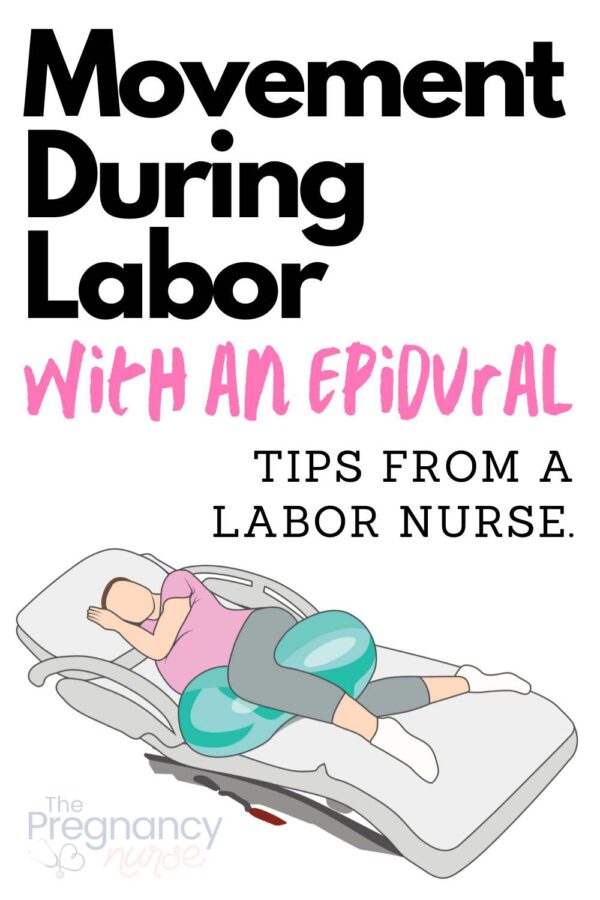👋 I’m so glad YOU are here. Are you looking to also get your partner prepared? This is for BOTH of you. Couples just love it and I know you want to both feel prepared!
A lot of birth education just stops once your cervix is fully dilated (also called “complete” or 10 cm) — but, now it’s time to PUSH. Average pushing time on your first baby is 2 hours, and most people want to minimize that if possible — so I’m really glad that you’re here to learn how to push.

Now, I think this post will be MOST helpful with a video — don’t worry it’s in the works. Stay tuned (and subscribe right here).
Really quick as a reminder labor is split into 4 stages:
1 – Early Labor: Up to about 4-6 cm
2 – Active Labor: from 4-6 cm to 10 cm
3 – Pushing: Once you’re 10 cm until baby is delivered ** That’s what we’re talking about today!
4 – Delivery of the placenta: This is the easiest phase, most people find
We’re going to go back to our elementary school report days and go over the important stuff — when to push, where to push, and HOW to push?
Want to know more about the phases or stages of labor — check out these posts:
- Stages of Labor Duration: How long does labor last?
- How Long Does it Take to Push Out A Baby?: The 3rd stage of labor
- 4 Things You Can Do to Prepare Your Cervix for Labor
- How to Prepare for Childbirth
I also have a video on this same topic:
When?
So, as you can see on my chart above — once you hit 10 cm it’s time to push. BUT, like most things in pregnancy, it’s not always that cut and dry.
For a long time it’s been thought to delay pushing for a bit — especially if baby is still high. And then you start to push with your body once baby is a bit lower. The idea here is to save mom’s strength, let her uterus do the work for a bit and then once baby is engaged, mom will push.
However, new studies are showing that delayed pushing can increase infection rates, and postpartum hemorrhage rates.
Cahill AG, Srinivas SK, Tita ATN, et al. Effect of Immediate vs Delayed Pushing on Rates of Spontaneous Vaginal Delivery Among Nulliparous Women Receiving Neuraxial Analgesia: A Randomized Clinical Trial. JAMA. 2018;320(14):1444–1454. doi:10.1001/jama.2018.13986
That doesn’t mean that delayed pushing isn’t right for some people. People who may want to consider it:
- You’re already exhausted, maybe you got a late epidural and you just need a nap
- People who have NO urge to push (maybe we turn down the epidural and give you 30 minutes to feel that pressure)
- The baby is still VERY high — maybe try some movements to help baby descend before you start pushing.
As a reminder it is always up to you when you start pushing. If they say you’re complete and it’s time to push, and you feel ready — then you make the choice to push.
If you’re complete and they say it’s time to push and you have NO energy you have a conversation about how things look like for you.
Honestly, I think some labor nurses have used “laboring down” as a way to get the next shift to deliver their patient. I’ve seen people laboring down for hours — and that’s never been good care. Yes, in certain circumstances maybe 30 minutes with good position changes, and maybe rest for mom can be a game-changer and leave her less tired.
But, sometimes it’s a lazy way to do nothing.
But, you didn’t hear that from me. 😜
Love how I pull back the curtain a bit on labor and delivery. I think tips like this can be REALLY helpful. We’re all just human and understanding how the “system” works can be a big win. I recommend this to help out!
Where?
Well, if you’re here — it’s likely going to be in the hospital that you’re pushing — but I’m talking more about the position you push in.
And frankly — this one is up to you.
I hear a lot of people saying that it hurts your pelvic floor to be in a specific position during pushing.
The reality is that all types of pushing does put a lot of pressure on your pelvic floor — and it’s different for every patient.
Pushing needs to sort of be put into 2 different categories (or periods of time):
Pushing before baby starts to stretch the perineum — this is most often done with your nurse (or sometimes midwife) at the bedside. This tends to be the longest part of things (especially on your first baby).
Pushing once the perineum is really stretching (often called crowning) — This is most often when the doctor is called for delivery.
While both types of pushing can cause issues with your pelvic floor, I think it’s important to remember that birth in general can cause issues with the pelvic floor. I recommend patients try a few positions (even more if they don’t have an epidural). If you find a position that is working for you, I say use it.
During labor there aren’t any studies that show one position is better than another for all patients. Every study I have read notes a lot of it is based off patient preference in how they are feeling best pushing. Often called shared decision making.
Also, patients with an epidural are limited in how they push. We can sometimes get you onto all 4’s to push, but within 15-20 minutes your hips hurt enough you want to try something else. You can still use a peanut ball and change sides or sit up and use a squat bar. There are options, just not things off of the bed as your legs won’t be able to hold you up. I have a whole post on using movement during labor with an epidural.
I hear a LOT about pushing from physical therapists on social media. I think it gets a lot of views, but they really haven’t read the studies OR actually pushed with patients — so, be mindful of that one. I’ve done both. 🙂
It’s important to know that protecting your perineum from a tear is different than pushing prior to crowning. How you push prior to baby crowning isn’t going to make a big difference in how you tear (although I recommend a few things including a cold compress in my post on how to prevent tearing).
Here are a few studies with links and the main conclusions:
This study showed that not being on your back reduced tearing and episiotomies.
Familiari A, Neri C, Passananti E, Marco GD, Felici F, Ranieri E, Flacco ME, Lanzone A. Maternal position during the second stage of labor and maternal-neonatal outcomes in nulliparous women: a retrospective cohort study. AJOG Glob Rep. 2023 Jan 17;3(1):100160. doi: 10.1016/j.xagr.2023.100160. PMID: 36825260; PMCID: PMC9941360.
This one showed that at delivery all 4’s and or kneeling was the best to prevent tearing (and I’d agree). It also showed that squatting made tearing worse.
Fay Lodge Melanie, Haith-Cooper. The effect of maternal position at birth on perineal trauma: A systematic review British Journal of Midwifery. 02 March 2016
This one showed that pushing more upright or laterally (on your side) was more helpful. It strongly recommended against laying on your back with feet in stirrups.
Huang J, Zang Y, Ren LH, Li FJ, Lu H. A review and comparison of common maternal positions during the second-stage of labor. Int J Nurs Sci. 2019 Jun 20;6(4):460-467. doi: 10.1016/j.ijnss.2019.06.007. PMID: 31728401; PMCID: PMC6839002.
Now is the part that I pull back the curtain and tell you this: Most doctors are really trained best to deliver you in a supine position. It makes it easy for them, they’re used to it and they do their best work in preventing tears at delivery at this point.
Your delivering provider does do a lot in preventing tears at delivery. Both in helping the perineum stretch and talking you through how to push right there at the very end to prevent you from tearing. It’s important to know that.
Many doctors scoff at the idea of not delivering patients on their back — but this is something you can bring up at prenatal appointments. Ask your provider if they’re comfortable delivering in other positions than with you on your back with your feet up in the stirrups. See what they say.
There’s lots of things you might want to ask your provider about for your delivery — doing a birth plan can be really helpful to start these conversation. I have a free series I give you a printable and walk you through it (there is a spot for delivery position preferences on my sheet):
As a note — how a provider delivers does say something to their routines of birth, and how open they are to letting the patient make the choices. As you have these discussions you may realize this isn’t the provider for you. While you may not be able to switch, it might be worth it to at least look around and see what your options are.
As a note: After delivery almost all patients will end up on their back with feet in stirrups so the doctor can clearly see if you have torn and if a repair will be needed. It’s important they do that as if a tear goes undetected (because you’re squatting) it could be really bad — we want them to be able to visualize the space well. But it does not mean you have to deliver that way — just that we’ll move you like that after delivery.
In summary on “where”:
- Try a few different positions as you start to push, see what feels good and helps baby descend well.
- Your DELIVERY position may be different than your pushing position (but trying to be side-laying or on all 4’s has been show to reduce perineal trauma)
- Talk with your provider about how they prefer to deliver
And, if you’re thinking you’d like to know more about labor & pushing positions I have some labor movement cards in here that can get the ball rolling on using movement to your benefit during labor.
How?
There are two types of pushing. And honestly, they’re pretty similar to how you poop when you’re constipated — so you can try them out now and see which works best for you.
Here’s a couple of studies that talk about it:
Closed- or open-glottis pushing for vaginal delivery: a planned secondary analysis of the TRAnexamic Acid for Preventing postpartum hemorrhage after vaginal delivery studyFroeliger, AlizéeSentilhes, Loïc et al.American Journal of Obstetrics & Gynecology, Volume 230, Issue 3, S879 – S889.e4
Chloé Barasinski, Anne Debost-Legrand, Denis Savary, Pamela Bouchet, Sandra Curinier, Françoise Vendittelli Does the type of pushing at delivery influence pelvic floor function at 2 months postpartum? A pragmatic randomized trial—The EOLE study AOGS 09 November 2022
Again, neither one really showed a huge benefit overall in the population. Some people really hate one or the other — so, decide which is right for you when you’re having your baby.
That second one did show some benefit to open glottis pushing on subsequent babies (vs your first) which makes sense. Often you’re only giving a few pushes and it makes sense to make it a bit less forceful on those deliveries.
To boil the act of pushing down — there is:
Open-Glottal Pushing: This is where you do a deep moan as you push. You’re not holding the air in — you’re more moaning and pushing down towards your bottom with your diaphragm.
Closed-Glottis Pushing: This is more like when you take a deep breath in to jump in the pool as a kid. You’re pulling that air in, and then pushing down with the air in your lungs on your diaphragm to push on the baby.
Pro Tip: I see some people saying “forceful pushing” can cause tears — and I want to be REALLY CLEAR that this is just at delivery time. During the other hours of pushing (especially on your first) you WANT to be forceful, you NEED to be forceful to get that baby to move. At delivery your provider will coach you with small pushes when your perineum needs time to stretch.
As for the two types — I think it’s smart to try both and see which you like better. You can even switch during your pushing time if you feel like one is getting less-effective. All of that is fine. You don’t have to stick to one type or position of pushing and go with it — you can adjust as you’d like!
I see a TON of stuff about pushing online. Most of it is from physical therapists who have not seen a lot of patients push (they’re going more on theory and possibly their own birth rather than a wide swath of people). The reality is that pushing is VERY personal — it’s just kind of how you get it done. Try a few things, see what works, ask for ideas from your team if you’re stuck and remember it can take quiet a while — even if you’re a GREAT pusher (especially on your first baby).
You know, I keep saying first baby, but my second baby was quite a bit bigger than my first baby — and it still took some time with him as those tissues needed to stretch more. So, you can’t always COUNT on it being fast — that being said, my 3rd was very quick (and smaller). So, you never know!
I love that you’re here learning about pushing — but I bet you’d love a teammate for this, not just someone over there scrolling Tiktok saying — go Kylie go! I recommend this to get them engaged in this process as well. I think you’ll find it so helpful!
So, what are you plans for pushing? Tell us down in the comments. And, tell me if you’d like me to include anything else in the video (or in future videos). I am here to help you guys out!






 Charlie Horses in Pregnancy: What you can do to prevent them?
Charlie Horses in Pregnancy: What you can do to prevent them?
